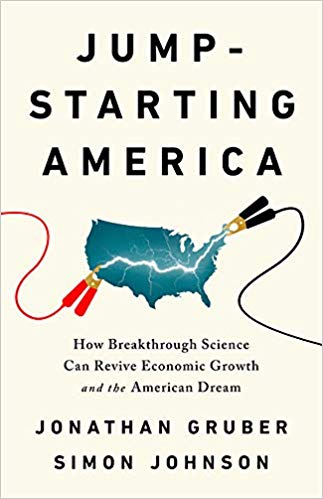You have /5 articles left.
Sign up for a free account or log in.
 Jump-Starting America: How Breakthrough Science Can Revive Economic Growth and the American Dream by Jonathan Gruber and Simon Johnson
Jump-Starting America: How Breakthrough Science Can Revive Economic Growth and the American Dream by Jonathan Gruber and Simon Johnson
Published in April of 2019.
The conversation that I’m hoping to have is with my conservative higher ed colleagues. I hope that Jump-Starting America might create an opportunity for listening.
The reason that I see an opportunity for dialog is not that Jump-Starting America is a book that I think conservatives will love. Quite the opposite. I guess that those who identify as to the right-of-moderate will be skeptical of the book’s arguments and conclusions.
What I want to hear are your reasons why you think that Gruber and Johnson - a couple of MIT economists - are getting things wrong.
Before we go over the main arguments for the book, and before I try to convince everyone that this book is worth the investment in time to read, let’s get clear about the types of conservatives I’d like to engage.
The conservative I’m looking for is of the economic type. This is a conservative who is deeply suspicious of government picking winners, and is believes mostly that the market (rather than planning) is the best mechanism to allocate resources.
I want to connect with conservatives who are likely to reject the main arguments in Jump-Starting America on philosophical grounds. But whom are also open to sifting through the evidence, engaging in debate, and having an open and collegial discussion.
My goal will not be to convince you that you are wrong to reject the conclusions of Jump-Starting America. Instead, I’m looking to be convinced that I’m wrong in accepting these conclusions.
What are the arguments advanced in the book?
Gruber and Johnson's thesis is that a country’s long-run productivity is based on its comparative levels of technological advancement and innovation. As wages, and the overall quality of living of workers, are deeply tied to productivity - then it is in the interest of everyone that society is technologically advanced.
The observed link between productivity and standard of living - or the availability of good jobs as Gruber and Johnson stress - is not controversial. Nor is it controversial - or particularly ideological - to observe that wages have been flat since the early 1970s, while economic inequality and wealth concentration has increased.
Where conservatives will have trouble with Jump-Starting America is in the book’s conclusion that the way to raise productivity, and grow lots more good jobs, is for the government to invest in technology.
Gruber and Johnson observe that almost all of the major technological advances that have created good jobs and wealth in the U.S. started as government-funded research projects. The list is long of technologies that we use every day, and which companies make millions (if not billions) on, but that started as government projects. That list would include: Google (original research supported by federal university grants), GPS, speech recognition, the smartphone, the internet, radar, digital cameras, jet engines, and so on and so on.
All of these technologies were either created or nurtured by initial investments by either the military or by federal funds. Would you be surfing the internet on your iPhone if the government had not invested in the underlying technologies that make these technologies possible? Unlikely.
The problem, as Gruber and Johnson see it, as almost all those technologies listed above came from government-funded projects with roots in the 1950 and 1960s. Since the 1970s, the government has devoted an ever smaller proportion of dollars (as measured as a percentage of GDP) to long-term research and development R&D.
In the place of government, the private sector has stepped in as the funder and large-scale technology research and of big science. As detailed in Jump-Starting America, the problems with relying on companies to fund technological innovation are that companies either have short-time horizons or that they invest in technologies that are most likely to bring that company economic gains.
Where R&D and big science spending by government tend to spill over to other industries, creating spinoff technologies and lots of new jobs, corporate R&D remains in company labs.
A second reason that Gruber and Johnson call for government funding of technological innovation - they target $100 billion a year - is that a reliance on private sector R&D has had the effect of increasing geographic inequality. High-productivity industries have concentrated on the coasts, driving up both wages and housing costs in a small number of superstar cities.
Government investment in biotech, clean energy, and other high-capital areas can be targeted to geographies outside of the usual urban suspects.
As evidence for the need for government to take an active role in long-term R&D investment, Gruber and Johnson point to Amazon’s search for a second headquarters. The choices of the DC and NYC areas - the book went to press before Amazon pulled out of Long Island City - is evidence that corporations are unlikely to invest in creating high-paying jobs in the places that need these investments most.
Local government subsidies to attract industries with high-wages tends to exacerbate the problem, as the regions with the greatest need for employment growth can least afford the handouts. A coordinated federal policy of local investment, one that would bypass the need for local tax giveaways, would be a much better system for allocating resources.
At this point I hope that the economic conservatives reading this book review have a good idea of the big arguments made in Jump-Starting America. Of course, Gruber and Johnson have written a book-length argument. So the synthesis that I have provided will be easy to refute.
Assuming both goodwill and technical expertise on the part of Gruber and Johnson - what are the arguments against their ideas?
Why would an economic conservative think it is a bad idea for the federal government to commit to funding long-term investments in technology, medical research, and energy?
The arguments in Jump-Starting America thoroughly convinced me. Where am I getting this wrong?
Can you recommend a balanced and non-polemical book, such as Jump-Starting America, that makes the counterarguments?
What are you reading?




